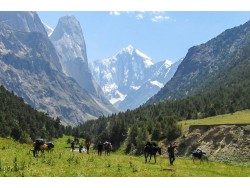Article Search
Search CriteriaArticle Search:
Articles meeting the search criteria
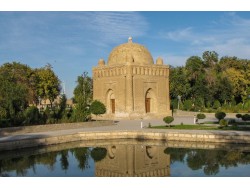
The Samanids mausoleum (9th-10th century) is the tomb of the Samanid dynasty, which used to rule Bukhara in the Middle Ages. A unique sample of the early medieval architecture, the mausoleum is one of the oldest monuments in Bukhara and Central Asia that have reached our days in a good state of preservation. Specialists hold the construction in high esteem as one of the Central Asian masterpieces and a true gem in the world’s architecture. The mausoleum was constructed between 892 and 943 by the order of Persian ruler Ismail Samani, the founder of the huge Samanid Empire, which covered the ter..
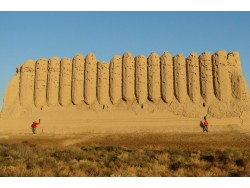
Mary is the third large city in Turkmenistan (till 1937 y. - Merv). It is located in large oasis among Kara-Kum sands in Murgab river delta. Mary was based in 1884 y. as Russian military-administrative center in 30 kilometers from ancient Merv. Now it is the largest center of rich cotton-growing region, large transport hub and the main center of natural gas industry of the country - the basic source of income of Turkmenistan.
The main sights are: the Museum of History with extensive collection of archaeological excavations, Turkmen carpets, national dressing, silver and excellent embroider..

Karakol – the biggest city and administrative centre of Issyk-Kul region is located on the foothills of Terskey-Alatoo ridge in the creek of Karakol river (in 13 kms from east coast of Issyk-Kul lake). This unique city is hidden from the outside glance among Central Tien-Shan ridges on 1770 m height above the sea level in the neighborhood with such majestic summits as Pobeda Peak (7439 m) and Khan Tengri Peak (6995 m). The area of the city is 48 sq. km with population about 70 thousand people.
"Karakol", that in translation means "the Black hand" was named after the same name of the river o..
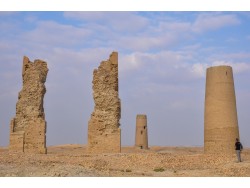
Misrian plain is one of the most unusual places in the territory of Turkmenistan. Intensive construction was not conducted here. This land is not suitable for the agriculture. Therefore many monuments of history are being preserved here.
The earliest signs of human activities on these former fertile lands relate to middle of II millennium B.C. In that period the largest settlings of ancient civilizations were located here: Madau-Depe, Izzatkuli and Tangsykyldja . There was the most powerful irrigating system in entire Central Asia. This historical region is widely known as Girkaniya. It flo..
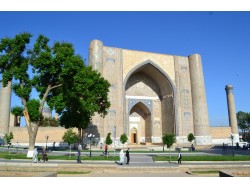
The whole world knows about the architectural miracle called the Taj Mahal. The emperor Shah Jahan built it to immortalise his favourite wife Mumtaz Mahal, whom he loved deeply. Several centuries before, Tamerlane the Great constructed the Bibi-Khanum mosque in commemoration of his favourite and beloved wife. This is a truly epic construction, so magnetic it is impossible to take one’s eyes off it. You should only see the dome of the mosque, which in ancient times was compared to the skies, and the arch of the portal, which was called by the lofty name of Milky Way.
The Bibi-Khanum mosque (..

Eternal snow and glaciers occupy approximately 4 % of the territory of Kyrgyzstan which is about 8 thousand km2. Inylchek is considered as the largest (60 kms) and fastest glacier of Kyrgyzstan having two sleeves named Northern and Southern Inylchek. It is located to the east of Issyk-Kul lake on Khan-Tengry massif, the most high and remote part of all Tien-Shan. The area is characterized by powerful glaciations. There are many above 6000 m summits (Khan-Tengry Peak (6995 m) is the highest among them) and Pobeda Peak (7439 m) here.
Southern Inylchek is the largest glacier of Tien-Shan and s..
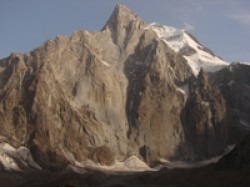
Aksu is located in the Turkestan ridge (Pamir-Alai), on the west side of Matcha mountain knot, and is located about 120 km to the south of Khujand city. Administratively Aksu refers to the Aksay district (Batken region, Kyrgyz Republic). The area is characterized by the beauty of untouched nature and unusual rock peaks, whose height often exceeds 5000 meters, such as Aksu (5355m), Block (5239m), Iskander (5120m) and many others. These mountains are made of dense granite, and the walls have a height difference of up to 1500 m. Rarely visited beautiful gorges, peaks and passes of the region crea..
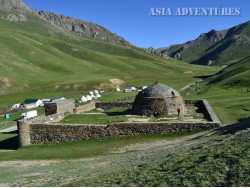
"Tash-Rabat" (XV c.) caravanserai is unique architectural monument of the early Middle Ages and one of the main archeological sights of Kyrgyzstan, being a symbol of Tenir-Too mountain architecture. It is situated in tash Rabat picturesque canyon-gorge (Naryn region) on 3200 m height. In times of the Great Silk road Renaissance "Tash-Rabat" served as a caravanserai, in our understanding an original "hotel", coaching inn for merchants and travelers on ancient caravan roads from Transoxiana to Kashgar.
Tash-Rabat is excellently entered in surrounding landscape. It looks like symmetric, almost..

Arslanbob is unique creation of the nature, a blossoming oasis at height of 1600 m above the sea level and one of the most beautiful resorts which is situated in the south of Kyrgyzstan.
The Arslanbob area is located in the tract of Babash-Ata ridge, on the western and southern slopes of Ferhana and Chatkal ridges and first of all it is well-known for its tremendous relic nut-fruit woods occupying 608,5 thousand hectares in total. These are the largest nut-fruit forest tracts on our planet. Up to 130 kinds of trees and bushes among which there are walnut, pistachio, almonds, pear, apple tre..

One more fantastic high-mountain Sonkul lake is located in the huge cavity between Sonkultau and Moldotau ridges on 3016 m height above the sea level. The lake stretches on 29 kms in length and on 18 kms in width, reaching 22 m depth. This is one of the largest high-mountain lakes and largest natural fresh-water reservoir of Kyrgyzstan with 278 km2 area. Sonkul lake has a tectonic origin. It is fed by small rivers flowing down from neighboring mountains. Sonkul river runs out from the lake and then flows into rapid Naryn river.
The transparent sparkling surface of Sonkul lake is visible fro..

Chil-Ustun Cave is located on the south-west of Kyrgyzstan in Osh Mountains, in 3,5 km from Aravan settlement.
A huge entrance in the cave in the form of arc with a height of 15 m and a length of basement ~ 25 m is located in the rocky group on almost plumb wall (the height under the say’s bottom) at the altitude of 1100 m.a.s.l. It’s necessary to have a definite knack and alpinist insurance is preferable to get the entrance along the steep oblique rock.
The cave has been known since ancient times, Arabian inscriptions on the walls are evidence of it.
The cave consists of 3 halls of d..
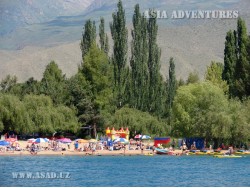
The Issyk-Kul lake is nonfreezing mountain miracle of tectonic origin located in the deep intermountain hollow between Kungey Ala-Too spurs and Terskey-Ala-Too ridge on the 1609 m altitude above the sea level. Mountain ridges protect the lake from cold air from the north and from hot breath of desert from the south. Therefore the local climate is warm and soft – here exhausting heat and strong frosts don’t happen.
Issyk Kul is one of the biggest and most beautiful high-mountain lakes of the world (it has 170 km length and 70 km width, being the second-largest mountain lake in the world afte..
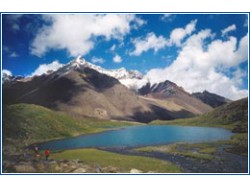
The most beautiful and picturesque lake of West Kyrgyzstan is the high-mountain Sarychelek lake - one of the main sights of Chatkal ridge. Sarychelek name literally means and is interpreted sometimes as “yellow vessel”, “yellow barrel” or “yellow bucket”. But that is the truth in autumn only. The lake is stretched from northwest to southeast on 7.5 kms, having filled by water the 507 hectares area and is situated on 1940 m height above the sea level. It was formed as a result of earthquake when the monstrous rocky landslide dam blocked Khodja Ata – one of inflows of Kara-Suu river.
Dozens o..

Grigorievsk Gorge (Kyrgyz name Chon Ak-Suu) is located on the northern shore of Issyk-Kul Lake, 60 kilometers from Cholpon-Ata city near the village of Grigorievka. The valley of Chon-Ak-Suu descends to Issyk-Kul from the Kungei Ala-Too mountain range. The length of the gorge is 35 km
Grigorievsk Gorge is considered as one of the most famous part of Issyk-Kul. Healing and saturated air, green mountain slopes covered with Tien-Shan firs, noise of mountain rivers, high-mountain lakes, alpine meadows, picturesque mountain landscapes are the reason of attraction of tourists to Issyk-Kul. Here y..

“Skazka” Gorge is located on the south coast of Issyk-Kul, near to Tosor village in 4-5km away from the main road. We highly recommend you to visit this place if you will be in Issyk-Kul.
“Skazka” Gorge is a unique place, formed by sandstones mineralized multicolored inclusions. Water and wind were natural sculptors who created amazing castles, towers and figures of fabulous animals
“Skazka” Gorge located on the southern coast of Issyk-Kul, in the foothills of the Terskei Alatau ridge, near the village of Tosor (between the villages of Kadzhisay and Tamga), 4-5 km from the Balykchy – Kar..

For million years, in the mountains of Central Asia, a lot of caves were formed, each of which is unique in its own way. They differ from each other by their size and depth, geological resources, in which they are formed, braided by many kilometers of labyrinths, bottomless abysses and the miraculous beauty of the underground halls.
Caves are usually formed in readily soluble geological rocks (limestone, gypsum, chalk, salt). Rain and snow waters, penetrating through barely noticeable cracks deep into the earth, micron per micron dissolve the rock, sometimes forming colossal underground hal..

The contrast Naryn region with the area located in the southeast part of the country at 1500-2500 m height above the sea level occupies the ? part of territory of the country. Mountain ridges, interchanged with deep intermountain cavities, large forest massifs, deserts, steppes and water reservoirs occupy more than 70 percent of territory of the region.
Naryn region has unique tourist resources: picturesque passes, deep gorges, the rapid mountain rivers, tremendous lakes and water falls, eternal snows and glaciers, and also ancient original culture – all this makes the area unique.
Naryn..

Al- Aziz restaurant is located near the center of the city, on the coast of Ankhor river. Restaurant has 2 big halls for holding banquets, corporate parties, business meetings and family dinners.
You can also sit on the outside of the hall, near fountain, or on the open air veranda. In the restaurant you will be offered different meals of European and National cuisine. Also, you can order meal delivery in this restaurant. Any order will be done in 30 minutes.
..

Artistic ceramics is one of the most ancient and interesting types of applied arts in Uzbekistan. The earliest ceramic items discovered by archaeologists in the territory of the country date back to very ancient times. The articles found include lagans (large plates), hemispherical pialas and kosas (bowls), vases, khums (large jugs), and jugs of various dimensions – from large to the tiniest, very delicate and convenient at the same time. Ceramic articles have always been in high demand in the region. Many of those items produced today in Uzbekistan are distinguished by high level of performan..

The Shark Taronlari International Festival is the most popular and prestigious song competition and festival in Central Asia. The festival is organised in the famous Registan Square in legendary Samarkand once in two years. In 1997 the event initiated by President of Uzbekistan Islam Karimov took place for the first time. Shark Taronalari will be held from 26th to 30th of August.
The festival is a competition between performers of ethnic music representing countries from all over the world.
In 2017 over 250 solo performers – singers and dancers – and music bands from 60 countries ar..

The Magic of Dance International Festival is traditionally organised in ancient Khiva, Khoresm province, Uzbekistan, in early September (in 2017 between 7 and 9 September). The festival features professional dance ensembles and amateur folk bands from Khorezm and other regions of Uzbekistan. At the event people can see the whole range of diverse traditional dances, performances from folk bands and ensembles, animation programmes, craftsmen’s exhibitions, puppet theatre shows, and demonstrations of traditional clothes, as well as an Uzbek cuisine festival, photographic exhibition The History of..

Silk and Spices is one of Uzbekistan's oldest festivals. The event is traditionally organised in the wonderful ancient Bukhara in May, every year since 2001.
A spectacular and colourful parade carrying the viewer to the world of Central Asian legends organised near Labi-Khauz in the centre of Bukhara opens the festival. The event features hundreds of people in traditional clothes, actors, dancers, acrobats, wrestlers and musicians performing traditional ceremonial tunes, all marching through Bukhara’s historical centre. The festifal’s epicentre then moves to a large traditional bazaar, wher..
Baisun is the centre of a district in Surkhandarya province located 150 km north of the city of Termez in the south of Uzbekistan. This green and cosy town rests at the foot of the Ketmen-Chapty Mountains in the Baisuntau Range. What makes the town famous is that each family in Baisun is keen to preserve ancient rituals, traditions and customs originating from the pre-Islamic pagan culture and pass them from generation to generation. That was the place where akyns (folk poets and singers) composed heroic epic Alpomysh a thousand years ago. Baisun is a region where an authentic musical culture ..

The principal holidays in Uzbekistan today are Navruz and the Independence Day.
The Independence Day is celebrated on 1 September since 1991, when Uzbekistan gained the status of an independent country. This day is distinguished by large numbers of people walking in the streets of every town and village, listening to folk bands and partaking of the holiday feast.
The tradition of celebrating Navruz has come from the Zoroastrian times. This day is celebrated on 21 March and marks the beginning of a new year. On this occasion people are dressed in the best clothes and cook the best meals. ..
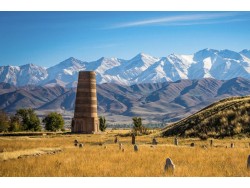
Buran Tower is the minaret of the Djami mosque that is located in Balasagun city- the capital of medieval Carhan khanat that was destroyed during the invasion of Mongol-Tatars in the XIII century. This tower is the only thing that was left from this huge city.
Buran Tower is located 12 km south-west of the town of Tokmak and 80 km east of Bishkek, the capital of Kyrgyzstan, in the foothills of the Kyrgyz ridge on the left bank of the Chu River. According to data it was built in X—XI centuries. Originally, the height of the tower was no less than 40 meters, however, its upper par..

Ayaz-kala fortress (from Turkic – frosty, cold) is located in the north-west of Elikkalin district of the Republic of Karakalpakstan in 30 kilometers from Buston settlement and in 30 kilometers from Khiva and it is the most showy one among other fortresses of ancient Khoresm. In real, there is no one fortress, there is a complex of three fortresses, grouped around a hill in the eastern part of Sultan Uizdak ridge.. more...
The first fortress – Ayaz-kala I, located on the top of a high hill and rising above surrounded desert, it was one of the most reinforced fort outlying the desert Kyzylkum...
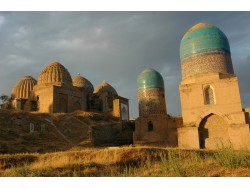
The Shakhi-Zinda necropolis is situated in the northern part of Samarkand, on the hills of ancient Afrosiab. The historical core of this ensemble is the mausoleum of Kusam ibn Abbas, Muhammad’s cousin, who, according to Arab chronicles, arrived in Samarkand in 676. There he disseminated Islamic ideas and was killed by heathens during a prayer. Among people, however, Kusam is known under the name of Shakhi-Zinda (live king), as, according to a legend, he is still alive in the other world.
In the following centuries his grave has been deeply revered by Muslims. In our time the flow of pilgrims ..

The Amir Timour Square is the heart of the new Tashkent. The square named after Amir Timour (Tamerlane), an eminent medieval political and military leader who created an enormous empire stretching from the Caucasus to China and from Siberia to India and existing for about 200 years in the 14th-15th centuries, features a magnificent statue of the great ruler. An inscription on the pedestal says ‘Power is in justice’ in four languages.
The layout of the square is a system of 8 alleys diverging radially from the statue of Tamerlane and originating 8 streets, which intersect with the annular av..
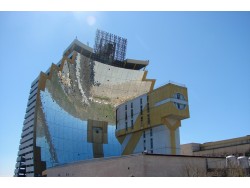
The solar complex PHYSICS-SUN is located in the Parkent district of the Tashkent region, 50 km northeast of the capital of Uzbekistan, Tashkent. Built in the 80s of the last century, the complex still impresses with its fantastic "cosmic" appearance, looking like a launch pad or an alien station.
The complex is located on a rocky hill at an altitude of 1100 m. in the picturesque foothills of the South-Western Tien-Shan. more...
The heliocomplex belongs to the Physics-Sun Institute of the Physics-Technical Institute of the Academy of Sciences of Uzbekistan and is dedicated for research in t..

Gur-Emir (translates as ‘the grave of the emir’) is the place where Tamerlane is buried together with his sons and grandsons. Initially, the mausoleum was built for Muhammed Sultan, Tamerlane’s grandson, who died young in 1403, during a military campaign. Shocked by the death of his favourite grandson whom he regarded as his heir, Tamerlane ordered to build a mausoleum in the territory of the ensemble of Muhammed Sultan. Muhammad Sultan was the son of Tamerlane’s eldest son, Jehangir, and often substituted his grandfather on the throne in Tamerlane"s absence. more...
The mausoleum is a one-do..
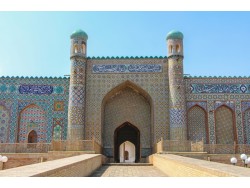
Kokand is a small but very interesting and important city with a long history, situated in the famous Fergana Valley 250 km east of the capital of Uzbekistan, Tashkent. Like many other towns and cities in the Fergana Valley, Kokand formerly known as Khovakand and Kavakend sprang up in a densely populated oasis on an ancient caravan route, which, according to 10th-century sources, ran through all major settlements in the valley. Local people were mostly engaged in crafts, agriculture and serving and guarding caravans. In the 13th century the Mongols destroyed the city. According to written sour..
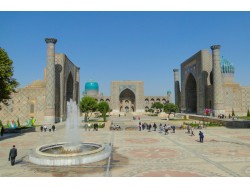
Bearing the name of ‘the pearl of Central Asia’, the Registan Square is regarded as one of the most beautiful squares in the world. The place gained fame through unique medieval oriental monuments surrounding it on three sides and forming a beautiful architectural ensemble: the Ulugbek madrasah (1417-1429), the Sher-Dor madrasah (1619-1636) and the Tilla-Kori madrasah (1646-1647). This ensemble occupies a place among the most significant constructions of the Islamic world. more...
All the three madrasahs (ancient oriental religious institutions) face the centre of the square forming a harmoni..
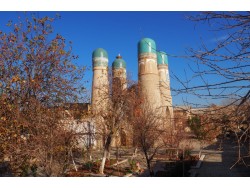
Chor-Minor (the name translates from Perisan as ‘four minarets’) is the most original and interesting construction in Bukhara situated deep inside an ancient residential quarter (mahalla) ten minutes on foot from Labi Khauz. Chor-Minor consists of an entrance portal (chartak) of an unusual shape with a dome and four low towers imitating minarets, whose domes were once decorated with blue tiles and drums covered with mosaics of bricks against a terracotta background (single blue and white slabs). The minarets’ trunks are constructed of polished bricks. The portal is the only element that has re..
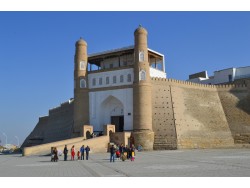
The Ark fortress is the most ancient archaeological monument in Bukhara. The legendary Siyavush, whom Firdousi glorified in his famous epic ‘Shahname", is considered to have constructed the fortress. The Ark was an administrative centre in the past. In front of the fortress there is a square named Registan. The Ark had two gateways. The eastern gates bore the name of Gurian, and the western ones – Registan, after the square they gave on to. The Ark fortress had the form of an irregular rectangle with the southeast corner slightly cut, a little elongated from west to east. The citadel of Ark is..

Workshop-museum of Bukhara dolls.
Walking in the central historical square you cannot miss the amazing small and cozy workshop-museum of Bukhara dolls made of paper mache.
The museum is established by IskanderKhakimov, who revived the nearly forgotten art of making traditional Bukhara dolls and who collected the ancient artifacts, documents and photos piece by piece.
Right from the threshold, tourists enter the amazing atmosphereof eastern tails and legends.
On the walls and shelves you can find wonderful dolls Ali-Baba with all of his 40 colleagues-robbers, Uzbek boogyman (yalmauzkamp..
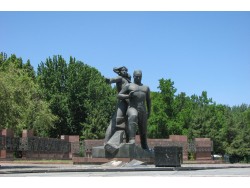
The monumental complex ‘Courage’ dedicated to the 1966 earthquake in Tashkent is one of the most significant monuments in today’s city.
On 26 April 1966, at 5:24 a.m., an earthquake with a magnitude of 8.3 shook the city. The incredibly strong seismic shaking changed Tashkent"s appearance forever. Half of the city’s inhabitants were left without a roof over their heads and had to live in tents. The earthquake had had its epicentre at a depth of 10 km right under the central blocks of Tashkent, in about the place where the Monument of Courage was erected.
Builders from all over the former..

Chimgan- is one of the most beautiful places in Uzbekistan, situated in 80 km to the northeast from Tashkent, the capital of Uzbekistan, in the mountains of the South-Western Tien Shan in the Ugam-Chatkal National Nature Park. Chimgan is under the administration of Bostanlik district of Tashkent region. more...
Chimgan is the most popular place of leisure among locals and guests of the capital city. It is not without reason that 150 years ago a summer cottage of the Tashkent Governor-General Kaufman was built. Chimgan is usually referred to as a vast territory from Beldersay to Charvak rese..
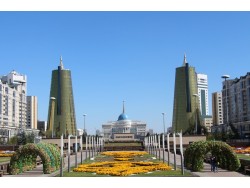
Astana, the capital of the Republic of Kazakhstan since 1997, is situated on a picturesque bank of the Ishim River.
The town of Akmolinsk acquired incorporated status in 1862. It had long been famous for its fairs. Merchants from all regions of Kazakhstan, Russia and the Central Asian countries traveled here. As the development of virgin lands began, the town was renamed Tselinograd and typified the administrative center of an agricultural region.
Since acquiring the status of capital the city"s face has changed dramatically. The architects and builders working in the capital create wond..

To travel in Kazakhstan you should have travel visa (Turkey citizens don"t need visa). Travel visa is to be issued by Kazakhstan embassy after receiving of invitation letter made with request of travel agency on behalf of the Ministry of Foreign Affairs of Kazakhstan.еще...>
For arranging visa support we need the following information:
Name, surname, sex, date and place of birth, passport number, date of issue and date of expiry, citizenship, nationality, permanent address, place of work and occupation, place of visa application, period of staying in Kazakhstan, number of entries to Ka..

Labi Hauz which is translated as ‘at the pond’ is one of the central squares of Bukhara situated in the southeast part of the city. The architectural ensemble was created in the 16th-17th centuries. The square has the form of an irregular polygon with the Divan-Begi madrasah in the eastern part. In the western part, opposite the madrasah, is the Divan-Begi khanqah. The khanqah is a small cruciform building with a domed hall in the centre and two storeys of khujras around it. The main façade is flanked with low towers and decorated with mosaics and interwoven ornaments running at its sides. The..
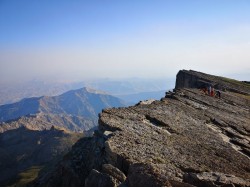
The cave named Alexander Vishnevskiy
The cave is located on the Chul-Bair massif of the Surkhantau ridge in the Surkhandarya region of the Republic of Uzbekistan.
The cave was discovered in 2015 during a joint expedition conducted by the Yekaterinburg speleo-club (GHS) and the Association of Speleologists of the Urals (ASU), a search team led by Vasily Samsonov (Orenburg), and surveyed to a length of 400 m and a depth of 70 m. The pioneers gave the cave conditional working name is ChB-15.
The cave is located in the eastern wall of the massif at an altitude of 3540 m. above sea leve..

There are more than thousand caves in Uzbekistan.
In terms of the number of caves, their depth and size, the caves of Uzbekistan are significantly ahead of all the famous caves of Central Asia taken together.
The biggest speleological discoveries in Uzbekistan started in the early 70s of XX century. As a result of these researches, more than 600 caves were discovered, including, the deepest abysses of the Asian continent: Boy-Bulok and Kievskaya, 16 km long labyrinth of Festivalnaya-Ledopadnaya cave systems.
In recent years, as a result of the persistent and fruitful work of Ural spel..

The rapid Sarytag, Khozormech and Serima Rivers flowing in wooded gorges and a talkative brook called Pescherny bring their cold waters into the lake. The sand and pebbles carried by the streams formed small flat grounds at each mouth, which are now covered with poplar, birch, aspen and juniper groves. The shore of Lake Iskanderkul is fringed with a narrow strip of willow, barberry, sweet briar and sea buckthorn shrubs. The bluish green water of the lake is quite cold, but it allows for swimming in closed bays and near the shore. In the winter Iskanderkul freezes all over, and only a current i..

The Instants of Eternity, an unusual ethno-cultural performance staged by the theatre of historical costume, will be a nice complement to your guided tour of Samarkand. During the show the actors demonstrate the costumes of different historical periods in Uzbekistan, from the Bronze Age to the present day.
There you can see clothes worn by the Saka and Massageatae, Zoroastrians, Persian and Sogdian rulers and noblemen and others. The theatre’s collection includes a wide range of colourful garments from the Timurid period, as well as traditional clothes from all of the present-day regions of..

The Jarkurgan Minaret commissioned by Sultan Sanjar and constructed by architect Ali ibn Muhammad Serakhsi in 1109, is one of Uzbekistan’s oldest minarets.
The monument is located in the village of Minor, 7 km from the town of Jarkurgan and 40 km from Termez.
The minaret has an original form and initially had two tiers, of which only one has remained to our days.
The tower is embraced by a continuous circle of 16 semi-columns, whose brickwork forms the ‘herringbone’ pattern. The base of the minaret is covered with extracts from the Koran, which, however, had not been finished. In form..

There are many tourists who wish to learn more about the life of local people. The most suitable for that purpose are the mountain villages of Asraf, Ukhum, Khayat, Majrum and Sentab situated on the southern slopes of the Nurata Range, near administrative centre Farish.
Each of these villages is hidden in a gorge and located 5 to 8 km from the Jizzah - Nurata road.
Tourists like to wander about the villages’ picturesque neighbourhoods, admiring the local nature and watching and listening birds. One of the visitors’ favourite activities is to walk on mountain paths from one village to ano..

The Zurmala Tower rising to the northeast of the Termez fortification walls of the Kushan period is one of the Buddhist monuments of ancient Termez. Probably, once there was a complex of Buddhist constructions in the area, but by the Middle Ages this territory had been turned into agricultural fields.
The only construction that has survived the time span of many centuries, though lost all its decoration, is a huge stupa – the complex’s central structure. By now it has lost its form completely, but, according to excavated data, the structure consisted of a rectangular pedestal, on which a cy..

The Museum of Archaeology was founded on 24 October 2001 in honour of the 2500th anniversary of the city of Termez, following a decree from President of Uzbekistan Islam Karimov. Featuring a diverse and unique collection, the museum has no rivals among its kinds in either Uzbekistan or other Central Asian countries. The internal space consists of 10 sections, each devoted to a certain theme. The museum’s entrance hall contains original stone and gypsum statues, large ceramic vessels, a stone pool and a map of Surkhandarya province with 20 archaeological monuments from different historical peri..

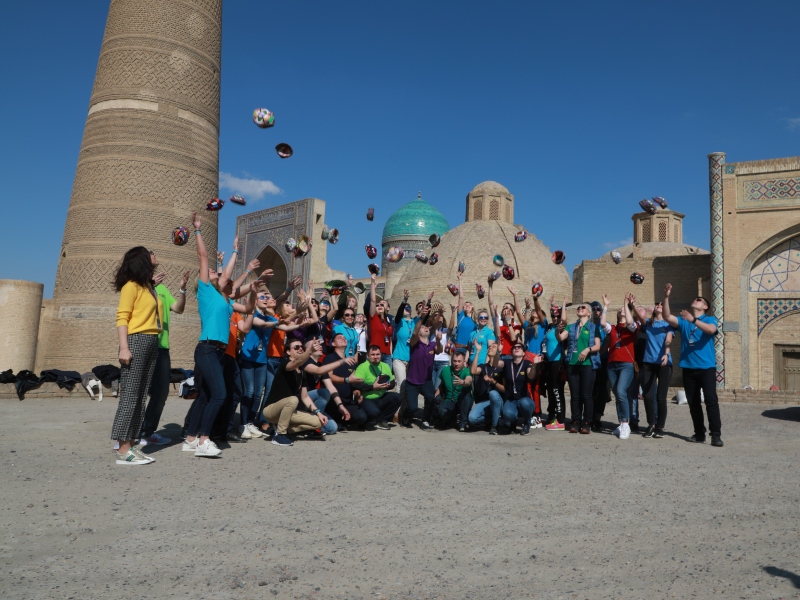 Centralasia Adventures
+998712544100
Centralasia Adventures
+998712544100




